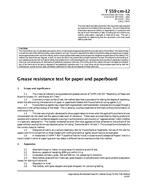Description
1.1 This classical method is an expanded and updated version of TAPPI UM 557 “Repellency of Paper andBoard to Grease, Oil, and Waxes (Kit Test).”
1.2 Commonly known as the kit test, the method describes a procedure for testing the degree of repellencyand/or the antiwicking characteristics of paper or paperboard treated with fluorochemical sizing agents (1,2).
1.3 Fluorochemical agents may impart both organophobic and hydrophobic characteristics to paper through areduction in the surface energy of the sheet. This is done by a surface treatment of the fibers without the formation ofcontinuous films.
1.4 This test was originally developed to allow papermakers to know when the applied fluorochemical wasincorporated into the sheet and the approximate level of resistance. These were accomplished by testing productionsamples with a series of numbered reagents (varying in surface tension and viscosity or “aggressiveness”) held in bottlesin a specially designed kit. The highest numbered solution (the most aggressive) that remained on the surface of thepaper without causing failure was reported as the “kit rating” (hence the term “kit test”). This concept forms the basis forthe current classical method.
1.5 Designed primarily as a surface repellency test for fluorochemical treatments, the use of this test forpapers with film-like barriers or those treated with nonfluorochemical agents would have to be evaluated.
1.6 A related test is TAPPI T 454 “Turpentine Test for Voids in Glassine and Greaseproof Papers” which ismore limited in terms of paper type and may detect a different failure mechanism than this method.
Product Details
- Published:
- 05/01/2012
- Number of Pages:
- 5
- File Size:
- 1 file , 47 KB
- Redline File Size:
- 2files, 390 KB
